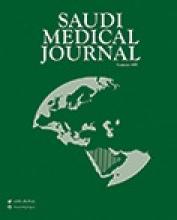SYSTEMATIC REVIEW
A systematic review of the prevalence and risk factors of smoking among Saudi adolescents
Alasqah et al systemically review the evidence concerning the prevalence and reported risk factors of smoking among adolescents in Saudi Arabia. They conclude that the prevalence of smoking is relatively high among adolescents in Saudi Arabia. The social influence of friends, teachers or parents, low academic performance, having spare time, living away from home, and the desire to relieve stress were the most commonly reported risk factors for smoking. Thirty-two studies that reported the prevalence of smoking in the adolescent age group were included in the narrative evidence synthesis. These studies were conducted on secondary school students (n=11), college students (n=14), and an adolescent age group without educational specifications (n=7). According to published reports between 2007 and 2018, the prevalence of tobacco smoking among adolescents in Saudi Arabia ranged from 2.4% to 39.6%. Influence of friends, and family negligence were the most commonly reported risk factors for smoking.
see page 867
ORIGINAL ARTICLES
The relationship between the nutritional status and sleep quality of patients with atrial fibrillation
Şengül & Uysal evaluate the relationship between the nutritional status and sleep quality in patients diagnosed with atrial fibrillation as a cross-sectional correlational research. They conclude that the patients’ sleep quality worsened and their daytime sleepiness increased as the risk of malnutrition increased. Of the patients, 47.2% were men and 52.8% were women. Most of them (81.5%) were over the age of 60 years. The mean age was 68.99±14.02. Of the patients, 13% were malnourished, 57.4% were at risk of malnutrition, and 29.6% had a normal nutritional status. This study determined that their sleep quality worsened and their daytime sleepiness increased as their risk of malnutrition increased (p=0.000).
see page 922
Distribution of malnutrition indicators according to nutritional status scores (N=108)
CASE REPORT
Surgical repair of bilateral congenital diaphragmatic hernia associated with hepatopulmonary fusion
Bawazir presents a 5-week-old male infant weighed 3.24 kg with suspected diaphragmatic hernia and congenital heart disease. The patient had respiratory distress immediately after birth and required resuscitation and mask ventilation. The appearance, pulse, grimace, activity, and respiration (APGAR) scores at 3 minutes was 6 and at 5 minutes was 7. The patient required mechanical ventilation and surfactant therapy for one week before being transferred to our institution. Chest x-ray and chest computed tomography scan confirmed the diagnosis of bilateral congenital diaphragmatic hernia with liver herniation on the right side and the spleen, the left adrenal gland and part of the stomach on the left side. They conclude that bilateral congenital diaphragmatic hernia is rarely associated with hepatopulmonary fusion and partial anomalous pulmonary venous drainage. Proper preoperative planning and special attention during surgical repair are required to avoid injury to the anomalous pulmonary venous drainage and the abnormal blood supply of the right lung.
see page 949
Chest CT scan (coronal view) showing bilateral diaphragmatic hernia (arrows).
- Copyright: © Saudi Medical Journal
This is an open-access article distributed under the terms of the Creative Commons Attribution-Noncommercial-Share Alike 3.0 Unported, which permits unrestricted use, distribution, and reproduction in any medium, provided the original work is properly cited.








